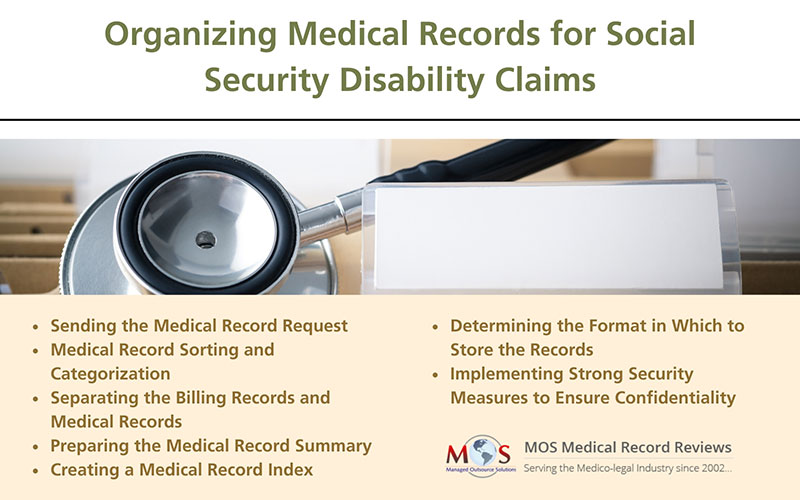A legal case chronology is vital to any illness or injury case, as well as social security disability claims. This can be prepared only after proper organization of the complete medical record set. The major concern with medical records is that most of the time, when you receive them from the medical record custodians they are in a disorganized and unstructured format. To even begin to review the records, they have to be put in proper order. Medical record organization is therefore the primary concern of an attorney handling disability cases and other medical legal cases and claims.
Maintain properly organized medical documentation with medical record organization solutions from us!
Steps Involved in Medical Record Organization
With a properly organized medical record set, it becomes easier to supply the SSA (Social Security Administration) with the claimant’s medical history. This history will include the diagnosis of the disability, the treatments provided, and documentation to explain the intensity of the disability and the need for compensation. The medical records gathered should establish that a disability exists, as well as its intensity and the period for which it is likely to exist. Apart from this, the medical documentation should record the progress of the claimant’s condition following the treatment(s). The prescriptions provided, their side effects if any, and details of the claimant’s daily activities must all be recorded clearly.
Here are the steps by which the medical records are properly organized.
- Sending the medical record request to various providers and facilities: The medical records you need to collect would include lab assay results, physicians’ notes, prescriptions, discharge summaries, consultation reports or reports from specialists, radiology reports, physical therapy/occupational therapy notes and so on.
- Medical record sorting and categorization: Once the complete set of records is obtained, the next step is to sort and categorize them into different types of records – physicians’ notes, lab reports, and others. When the categories are finalized, you can organize the records chronologically in each category.
- Organize the billing records and medical records separately so that the claim processing becomes easier and hassle-free.
- Prepare a medical record summary: This should contain the main information such as details of the patient (name, date of birth, and contact information); medical history; diagnoses; treatments provided and their timeline; functional limitation imposed by the impairment or disability; medications recommended, present as well as past; and relevant dates.
- Store the records in the preferred format: You can store the records in paper format utilizing paper files. The more preferred option today is digital format where you can store the records in your computer database or in the cloud. Digital storage systems include EHR systems, and cloud storage using Google Drive, Dropbox or a suitable legal case management software.
- Create an index for ease of reference: A table of contents or index of medical records is the best way to ensure easy reference and review. You can highlight particular sections using labels or color-coded tabs.
- Ensuring security and confidentiality of the medical records: Since patient healthcare data is highly confidential, it is vital to have in place robust security measures. When storing the records digitally, you can have access controls and file encryption. Also, if you need to share the records with other lawyers or medical experts, the transfer has to be done with utmost attention to the safety of the documents.
How Medical Record Organization Assists Social Security Disability Attorneys
Properly organized medical records assist disability attorneys to more easily determine the mental or physical impairment of the claimant that prevents him/her from performing routine work-related tasks. Also, it is easier to understand whether the claimant has been following the treating physicians’ instructions regarding the recommended treatments. This is very important when it comes to social security disability determination. Organized medical records allow attorneys to distinguish one record from another such as patient history, test results, treatments, physician orders and so on. They support the attorney’s litigation needs and present a clear picture of the claimant’s medical history. The records can be easily reviewed and the relevant medical evidence extracted. Irrelevant records can be identified and removed, and an accurate timeline or chronology prepared at the earliest. This in turn speeds up case preparation and presentation. With a perfect understanding of the claimant’s disability and limitations, attorneys can effectively present the claim and secure the rightful compensation for their clients. Social security disability attorneys can save their valuable time and effort by utilizing medical record review services from an experienced medical review company.
Find out why MOS Medical Record Reviews is the right partner for your law firm!
Call 1-800-670-2809 and experience top-quality medical record review services.





